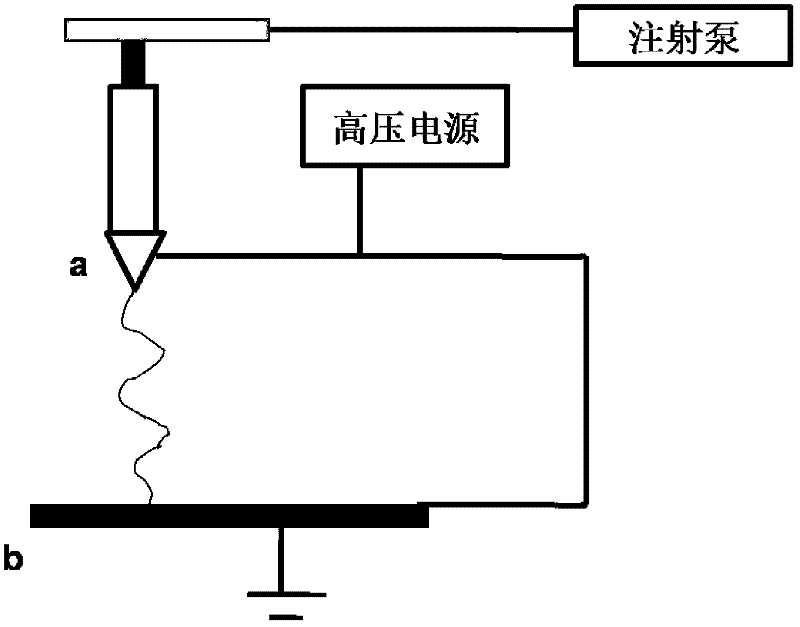Method for preparing electrode material for all-vanadium flow battery
A technology for all-vanadium redox flow batteries and electrode materials, applied in battery electrodes, circuits, electrical components, etc., can solve the problems of transition metal oxides that cannot exist stably for a long time, easy to damage the physical properties of carbon fibers, and limited specific surface area of carbon fibers. The experimental conditions are easy to meet, the electrode reaction area is enlarged, and the price is low.
- Summary
- Abstract
- Description
- Claims
- Application Information
AI Technical Summary
Problems solved by technology
Method used
Image
Examples
Embodiment 1
[0032] 1) Add polyacrylonitrile with a mass fraction of 10% to nitrogen and nitrogen dimethylformamide under stirring conditions, and stir for 2 hours at a water bath temperature of 60° C. to obtain a composite spinning solution. The average molecular weight of polyacrylonitrile is 150,000 .
[0033] 2) Add multi-walled carbon nanotubes with a mass fraction of 5% (relative to the amount of polyacrylonitrile) into the spinning solution in step 1), and stir for 12 hours to obtain a uniformly mixed spinning solution.
[0034] 3) Add the mixed spinning solution through step 2) into a 20ml syringe, the diameter of the pinhole is 1.0mm, the distance between the pinhole and the current collector is 12cm, the voltage between the two is 20kV, and the current collector is 200 microns thick Carbon paper with an injection rate of 0.5 ml / hour.
[0035] 4) Put the electrode precursor material obtained in step 3) into a vacuum / atmosphere furnace, the pre-oxidation temperature is 300°C, the ...
Embodiment 2
[0039] The difference with Example 1 is:
[0040] 1) Polyethylene glycol with a mass fraction of 10% is added to nitrogen and nitrogen dimethylformamide under stirring conditions, and the water bath temperature is 40°C and stirred for 3 hours to obtain a composite spinning solution. The average molecular weight of polyethylene glycol for 8000.
[0041] 2) Graphite oxide with a mass fraction of 5% (relative to the amount of polyethylene glycol) was added to the spinning solution in step 1), and stirred for 12 hours to obtain a uniformly mixed spinning solution.
[0042] 3) Add the mixed spinning solution through step 2) into a 20ml syringe, the diameter of the pinhole is 0.7mm, the distance between the pinhole and the current collector is 15cm, the voltage between them is 30kV, and the current collector is 200 microns thick Carbon paper with an injection rate of 0.5 ml / hour.
[0043] 4) Put the electrode precursor material obtained in step 3) into a vacuum / atmosphere furnace,...
Embodiment 3
[0047] The difference with Example 1 is:
[0048] 1) Add polyacrylonitrile with a mass fraction of 20% to nitrogen and nitrogen dimethylformamide under stirring conditions, and stir for 5 hours at a water bath temperature of 50° C. to obtain a composite spinning solution. The average molecular weight of polyacrylonitrile is 100,000 .
[0049] 2) Add multi-walled carbon nanotubes with a mass fraction of 3% (relative to the amount of polyacrylonitrile) into the spinning solution in step 1), and stir for 10 hours to obtain a uniformly mixed spinning solution.
[0050] 3) Add the mixed spinning solution through step 2) into a 40ml syringe, the diameter of the pinhole is 1.0mm, the distance between the pinhole and the current collector is 10cm, the voltage between them is 35kV, and the current collector is 200 microns thick Carbon paper with an injection rate of 1 ml / hr.
[0051] 4) Put the electrode precursor material obtained in step 3) into a vacuum / atmosphere furnace, the pre...
PUM
| Property | Measurement | Unit |
|---|---|---|
| Thickness | aaaaa | aaaaa |
| Thickness | aaaaa | aaaaa |
Abstract
Description
Claims
Application Information
 Login to View More
Login to View More - R&D
- Intellectual Property
- Life Sciences
- Materials
- Tech Scout
- Unparalleled Data Quality
- Higher Quality Content
- 60% Fewer Hallucinations
Browse by: Latest US Patents, China's latest patents, Technical Efficacy Thesaurus, Application Domain, Technology Topic, Popular Technical Reports.
© 2025 PatSnap. All rights reserved.Legal|Privacy policy|Modern Slavery Act Transparency Statement|Sitemap|About US| Contact US: help@patsnap.com

